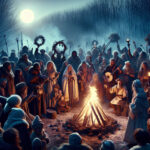The pagan calendar has been celebrated for centuries, and has been an important part of many cultures and religions around the world. It is a calendar that is based on lunar cycles, and is typically associated with paganism, a religion that is based on the worship of nature and the cycles of the universe. This article will explore the history, significance, and uses of the pagan calendar. It will also explore how it is practiced today, and how it can be used to help us better understand our place in the natural world.
The pagan calendar is an ancient system of measuring time that has been used in many cultures throughout history. It is based on the natural cycles of the sun and moon, and is still used today by some modern pagans. The pagan calendar is divided into four seasons or four festivals, each associated with a particular deity or mythological event. The four festivals are Imbolc, Beltane, Lughnasadh and Samhain. Each of these festivals has its own rituals, traditions, and beliefs associated with it.
What is Imbolc?
Imbolc is the first of the four festivals, and is celebrated on February 1st or the first full moon of spring. It is the festival of the goddess Brigid, and is a time of renewal and rebirth. It is a time for honoring the goddess and her many aspects, and for welcoming the spring. Imbolc is a time for purification and cleansing, for lighting candles and for making fresh resolutions.
What is Beltane?
Beltane is the second of the four festivals, and is celebrated on May 1st or the first full moon of summer. It is the festival of the god Bel, and is a time of fertility and growth. It is a time for honoring the gods, and for celebrating the abundance of life. Beltane is a time for dancing and feasting, for gathering together to celebrate the joy of life.
What is Lughnasadh?
Lughnasadh is the third of the four festivals, and is celebrated on August 1st or the first full moon of autumn. It is the festival of the god Lugh, and is a time of abundance and harvest. It is a time for honoring the gods, and for celebrating the bounty of the harvest. Lughnasadh is a time for feasting and giving thanks, for gathering together to celebrate the richness of life.
What is Samhain?
Samhain is the fourth and final of the four festivals, and is celebrated on October 31st or the first full moon of winter. It is the festival of the goddess Morrigan, and is a time of death and transformation. It is a time for honoring the dead, and for reflecting upon the cycle of life and death. Samhain is a time for divination and meditation, for gathering together to remember those who have passed.
What are the rituals associated with the pagan calendar?
Each of the four festivals has its own rituals and traditions associated with it. At Imbolc, pagans often light candles to represent the return of the light. At Beltane, pagans may dance around the Maypole to celebrate the fertility of the land. At Lughnasadh, pagans may hold a feast to honor the gods and give thanks for the harvest. At Samhain, pagans may practice divination to see what the coming year holds.
What is the Wheel of the Year?
The Wheel of the Year is a representation of the pagan calendar, and is often used in rituals and celebrations. It is a circle divided into eight sections, each representing one of the eight festivals. The festivals are arranged in a cycle, so that when one festival ends, the next one begins. This cycle represents the changing of the seasons, and the cycle of life and death.
How do I celebrate the pagan calendar?
There are many ways to celebrate the pagan calendar. You can attend rituals and festivals held by local pagan groups, or you can create your own rituals and celebrations. You can research the deities and myths associated with each festival, and use them as inspiration for your own celebrations. You can also use the Wheel of the Year as a reminder to take time to celebrate each festival.
The Pagan calendar is an ancient system of tracking time that has been used by many cultures throughout history. It is based on the cycles of the sun, moon, and stars, and is used to determine the timing of festivals and celebrations. The Pagan calendar is an important part of the spiritual practice of many Pagans, and is a reminder of the interconnectedness of all things in the universe. It is a tool that can be used to bring people together and to honor the natural world. Ultimately, the Pagan calendar is a powerful way to connect with the cycles of nature and to celebrate the beauty of the world around us.





